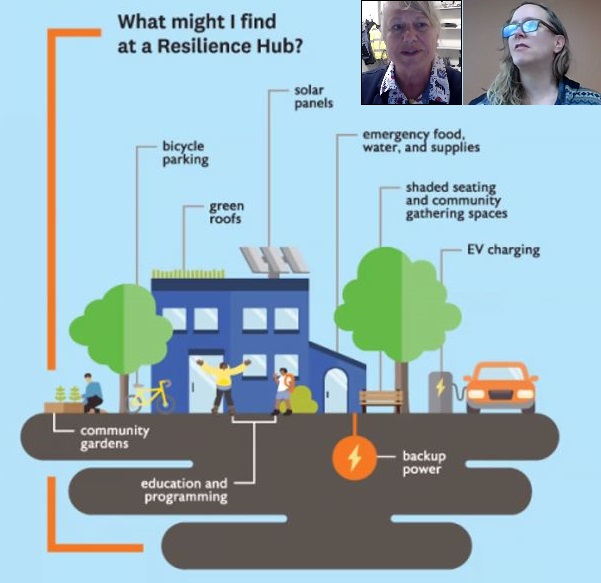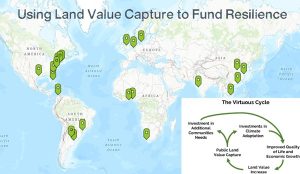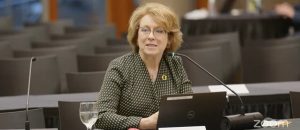Lane County sees the wave of the future in island mapping, resilience hubs
6 min read
Lane County officials share an update on their resilience hub grant for nearly $20 million. With the COAD on Sept. 12:
Jo Rodgers (Lane County Public Health): Jo Rodgers, she/her pronouns, with Lane County Public Health in the Emergency Preparedness Program.
[00:00:15] The idea is that there will be six resiliency hubs kind of anchoring across the county. And then we call it an ecosystem because it really is like this image of a forest ecosystem: the mycelial interconnections that will branch out from those hubs and form social networks and offerings of resources and skill-building and community development and engagement into smaller hubs and smaller clusters that maybe aren’t a physical location, but are a social hub of sorts where we can offer workshops and other things…
[00:00:54] The partnership with United Way of Lane County was really attractive to us because of their strong community engagement work already in our community. So they’ll be leading that, and we’ll be working closely with them on that community engagement piece, because we see that as the heart essentially of this work is that we need to hear from the communities, both about their needs and their strengths and what it is that they want.
[00:01:17] So a community-led process for sure, to build community strength and reach priority populations across the county, and really aiming to just empower and strengthen our whole community, in particular, those who are maybe underresourced or historically marginalized, and being hit by all these climate impacts that are increasing in frequency and duration.
[00:01:40] So these six hubs, each one has its own budget attached, to develop a true emergency shelter space. So: cleaner air, cooler air, overnight sheltering, all that you can imagine at those six hubs.
[00:01:54] Volunteer development is going to be really hitched to the Public Health Reserve Corps program, enhancing communication and coordination across our county within these communities.
[00:02:05] We will be receiving $19.5 million: 64% going to those community hubs, upgrading them so they really can serve as an emergency shelter; 23% going to the United Way for the community engagement work, including some sub-awards that they will be rolling out with this grant; and then Lane County, 13%. There’s going to be some added staffing allowed, especially for United Way. There’s also some emergency supplies and equipment that will be a part of this grant, having caches of supplies for an emergency.
[00:02:39] All these sites are already community centers, operating really great programs for the community. They’re already recognized by the community as a hub. So this is just enhancing and upgrading the capacity of these sites.
[00:02:51] So: The Florence Center; the Veneta Fern Ridge Service Center (where Mid Lane Cares operates); Bethel – Fairfield Elementary School’s gym (the gymnasium that’s like an auxiliary building, will be a resilience hub); in Springfield, Willamalane Bob Keefer Center; dropping to the south to the Cottage Grove Community Center (also where the library is, they’ll be upgrading their facilities to be a resilience hub); and then in Oakridge, the Willamette Activity Center, offering a lot to the community there, these very smoky days that they continue to get pretty much year-round.
[00:03:27] There’ll be some solar feasibility studies at four of the facilities and EV charging added at five of those facilities. So it’s going to really help address the greenhouse gas reduction that we all want to see happen to slow things down.
[00:03:42] As far as the organizational structure of it: a steering committee and then six teams, so each team associated with one of the resilience hubs, and then those teams will be made up of various groups, including CBOs, business, government, and faith groups.
[00:04:01] Tiffany Brown (Lane County emergency manager): We had a meeting a couple weeks ago and were really advised that the first six months or so will really be a lot of planning and figuring out who does what and further defining what we’ve said we’re going to do, galvanizing, and then just figuring out how we’re going to achieve that moving forward.
[00:04:20] We’ll integrate the planning into our emergency operations planning. ESF-6 (Emergency Support Function 6) is Mass Care and that aligns directly with this project, which is taking care of people so that we’ve got advanced planning in place when response occurs and that our communications include the hubs and all that that entails.
[00:04:44] Identifying mitigation action items: If you’re not familiar with our NHMP (Natural Hazard Mitigation Plan), it’s identifying things that we can do ahead of emergencies and disasters to help us recover more quickly. And part of that role is just diving into events and incidents that have happened and performing an after-action review to identify where the gaps are and how we can make improvements in the future.
[00:05:11] So, anything that we can identify to improve the program moving forward, we’ll be moving into the Natural Hazard Mitigation Plan as an agreed-upon action item to improve our response.
[00:05:24] And we will take part in providing community education in preparedness, help (Lane County) Public Health support local volunteer response and capability, and just generally talk about response recovery and provide any expertise, resources or support that we’re able to as the emergency management agency.
[00:05:45] Some of you have heard me talk about ‘the mass care assessment.’ This is a concept that we started talking about after the ice storm. We talked about the different types of care that were needed, the resources that we have available. And at the end of the conversation, we decided that we really needed a document to frame the conversation so that we could talk about the same thing in the same way and start capturing that information.
[00:06:11] We have applied for funding to create a mass care assessment for the entirety of Lane County that would include the hubs, but also all additional respite and shelter locations; incorporate the island mapping concept that we’re starting to see emerge around earthquake preparedness; and identify potential gaps for all locations.
[00:06:33] As a county emergency manager of 15 years, this is the wave of the future. This is resilience hubs, people taking care of people, applying the island mapping that we saw happen even in the ice storm. And this is the way we’re going to start talking about preparing communities, in concentric circles.
[00:06:53] We want everyone to benefit from this project in any way they can, even if that’s not providing direct fiscal resources, but I envision (because this is the way my head works) that as we dive in and start building out these projects that we will do so in a transparent storytelling way that benefits every other community in this county that is interested in doing the same thing.
[00:07:18] John Q: Responding to questions from Community Organizations Active in Disasters (COAD):
[00:07:26] Tiffany Brown (Lane County emergency manager): Let me read the questions. ‘Given the significant overlap between the work COAD is already doing and the objectives of the grant COAD is implementing, how do you envision us collaborating effectively to maximize our impact?’
[00:07:40] Stand by. We’ll be in a planning phase for about the next six months.
[00:07:44] ‘What types of employment opportunities, particularly in community-based emergency management, do you anticipate will emerge as a result of the grant?’
[00:07:52] The funding that is going for employment I think is attached to United Way at this point. I think that there is money for United Way to hire outreach coordinators. Part of the funding also goes to paying volunteers and paying those within their own communities to come to the table to take training, to provide training. And so there’s a very community-based piece of it that has to do with providing employment or resources to those whom we will be serving.
[00:08:27] John Moriarity (McKenzie Long-Term Recovery Group): My name is John Moriarty with the McKenzie Valley Long-Term Recovery Group. And I just wanted to say: Thank you… It’s really exciting to see this become more formalized. We can actually support communities in preparing so that they don’t have to go through the establishment of an organization post-disaster, in the midst of the trauma and chaos without understanding support and really recognizing what those community assets are. So it’s really great to see this getting some formal support. I’m looking forward to collaborating with you all on that.
[00:08:59] John Q: Lane County sees the wave of the future in emergency management: Islands of sustainable self-sufficiency, built on mycelial networks of personal and organizational relationships. Lane County’s award of $19.56 million under the EPA’s Community Change Grant Program was funded by the Inflation Reduction Act.



